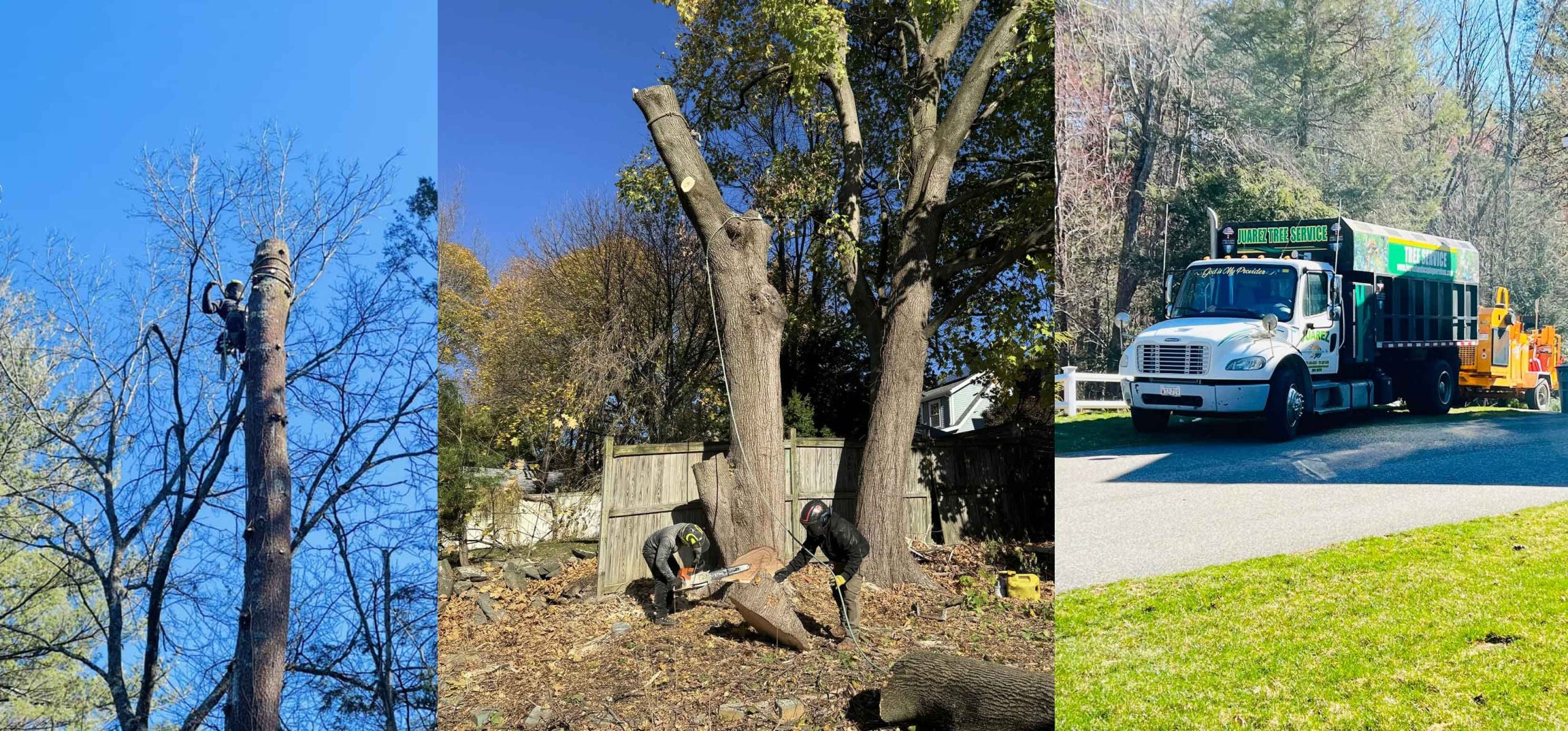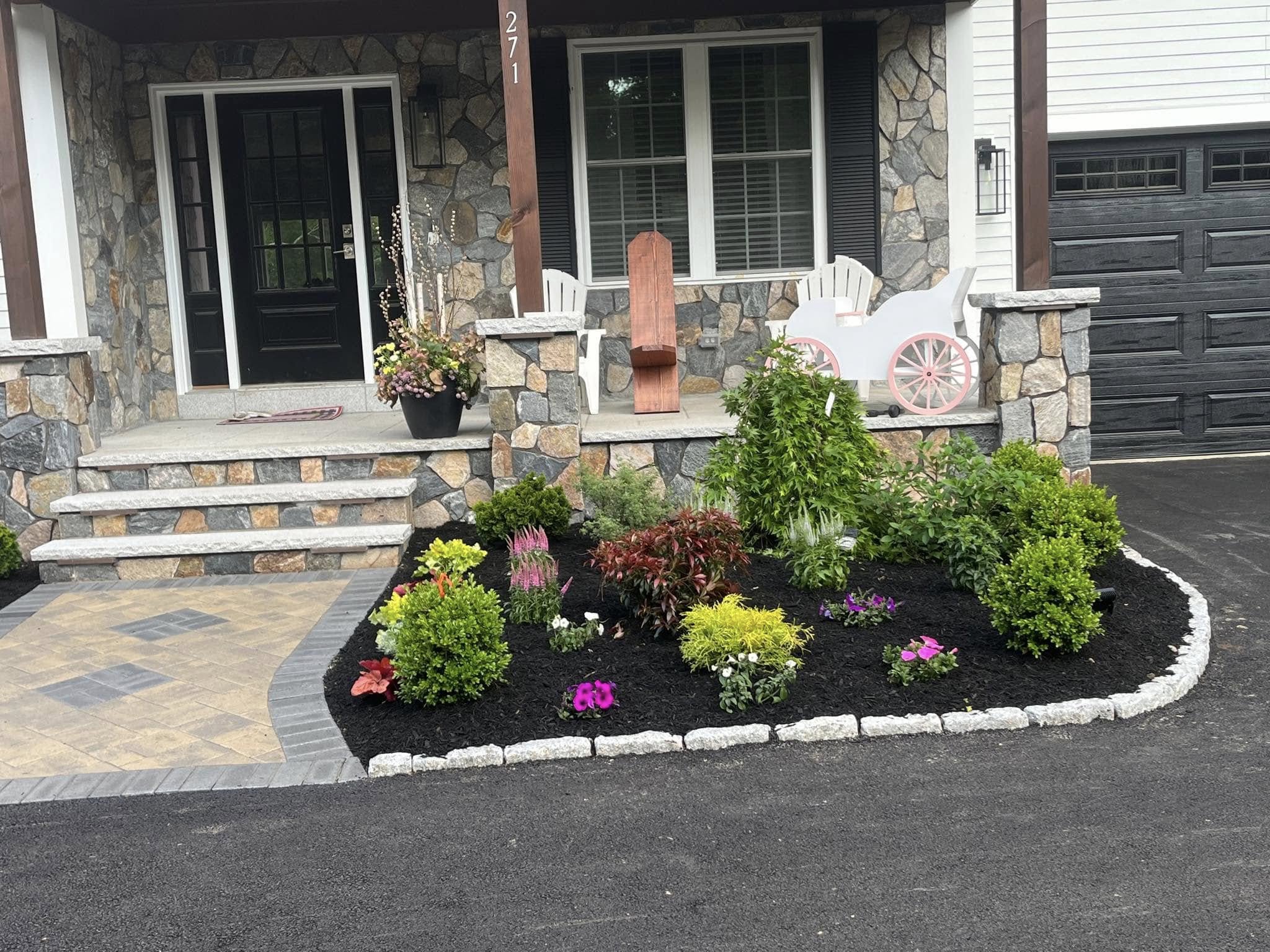Trees are vital components of our landscapes, providing shade, beauty, and environmental benefits. However, there comes a time when tree removal becomes necessary for safety, health, or aesthetic reasons. At Juarez Landscaping, we understand the importance of maintaining a beautiful and safe outdoor space. In this comprehensive guide, we’ll explore the top 10 signs that indicate it might be time to consider tree removal.
1. Visible Decay or Damage
One of the most obvious signs that a tree may need removal is visible decay or damage. Look for:
- Large dead branches
- Hollow trunk
- Extensive bark damage
- Fungal growth on the trunk or major branches
These signs often indicate internal rot, which can severely compromise the tree’s structural integrity. A decaying tree is not only unsightly but can also pose a significant safety risk to your property and loved ones.
2. Leaning Tree
While some trees naturally grow at an angle, a sudden or significant lean can be a cause for concern. This is especially true if:
- The lean has developed recently
- There are visible root problems
- The ground around the tree is heaving
A leaning tree may indicate root damage or instability, which could lead to the tree falling unexpectedly. If you notice a change in your tree’s angle, it’s crucial to have it assessed by a professional arborist promptly.
3. Root Damage
The health of a tree’s root system is crucial for its overall well-being. Signs of root damage include:
- Visible roots that are decaying or damaged
- Fungal growth near the base of the tree
- Soil heaving around the tree
- Construction damage in the root zone
Severe root damage can destabilize the tree and affect its ability to absorb nutrients and water, ultimately leading to its decline.
4. Disease or Pest Infestation
Trees can fall victim to various diseases and pest infestations. Watch for:
- Discolored or deformed leaves
- Excessive leaf drop
- Peeling bark
- Holes in the trunk or branches
- Visible insects or their signs (e.g., sawdust-like material at the base of the tree)
While some diseases and pest problems can be treated, severe cases may require tree removal to prevent the issue from spreading to other plants in your landscape.
5. Overcrowding or Interference
Sometimes, tree removal is necessary for the overall health of your landscape or to address practical issues:
- Trees growing too close together, competing for resources
- Branches interfering with power lines, structures, or walkways
- Roots damaging foundations, driveways, or underground utilities
In these cases, selective tree removal can improve the health and appearance of your remaining trees while addressing safety concerns.
6. Storm Damage
After severe weather events, trees may suffer significant damage that necessitates removal:
- Large broken limbs
- Split trunk
- Uprooting
- Lightning strikes
While some storm-damaged trees can be saved with proper care, others may be beyond recovery. A professional assessment can help determine the best course of action.
7. Dead or Dying Tree
A tree that is mostly dead or dying is not only an eyesore but also a potential hazard. Signs include:
- Bare branches during the growing season
- Brittle, dry wood
- Peeling bark on multiple areas of the tree
Dead trees are more likely to fall or drop large branches, making their removal a priority for safety reasons.
8. Extensive Cracks or Splits
Large cracks or splits in the trunk or major branches can indicate severe structural weakness. Look for:
- Deep, extending cracks in the trunk
- Split branch unions
- Multiple trunks separating from each other
These issues often cannot be effectively remedied and may require tree removal to prevent accidents.
9. History of Falling Branches
If a tree has a history of dropping large branches, it may be time to consider removal. This is especially true if:
- The fallen branches were healthy (not just dead limbs)
- Branches have caused property damage or near-misses
- The tree species is known for weak wood or branch structure
Repeated branch failure can indicate underlying health issues or inherent weaknesses that make the tree a liability.
10. Age and Decline
As trees age, they may enter a natural decline phase. While old trees can be beautiful and valuable to the ecosystem, they may also require removal if:
- They show multiple signs of decline (e.g., dieback, disease susceptibility)
- They pose a risk due to their size and proximity to structures
- The species has reached or exceeded its typical lifespan
In some cases, proactive removal of an aging tree can prevent future problems and allow for the planting of new, vigorous trees.
Professional Assessment is Key
While these signs can help you identify potential issues, it’s crucial to have a professional arborist assess your trees before making a final decision on removal. At Juarez Landscaping, our certified arborists have the expertise to evaluate your trees’ health, structural integrity, and potential risks.
We consider factors such as:
- The tree’s overall health and potential for recovery
- Its location and potential targets if it were to fall
- Local regulations regarding tree removal
- Alternative options like pruning or cabling
Our goal is always to preserve healthy trees when possible while ensuring the safety and beauty of your landscape.
Tree removal is sometimes necessary to maintain a safe and attractive outdoor space. By being aware of these signs and seeking professional guidance, you can make informed decisions about the trees on your property. Remember, early intervention can often save a tree, so don’t hesitate to contact Juarez Landscaping for expert tree care advice and services.
Whether you need tree removal, pruning, cabling, or general landscaping services, our team is here to help you create and maintain a beautiful, healthy landscape. Contact us today to schedule a consultation and keep your trees thriving for years to come.




Trees are vital components of our landscapes, providing shade, beauty, and environmental benefits. However, there comes a time when tree removal becomes necessary for safety, health, or aesthetic reasons. At Juarez Landscaping, we understand the importance of maintaining a beautiful and safe outdoor space. In this comprehensive guide, we’ll explore the top 10 signs that indicate it might be time to consider tree removal.
1. Visible Decay or Damage
One of the most obvious signs that a tree may need removal is visible decay or damage. Look for:
These signs often indicate internal rot, which can severely compromise the tree’s structural integrity. A decaying tree is not only unsightly but can also pose a significant safety risk to your property and loved ones.
2. Leaning Tree
While some trees naturally grow at an angle, a sudden or significant lean can be a cause for concern. This is especially true if:
A leaning tree may indicate root damage or instability, which could lead to the tree falling unexpectedly. If you notice a change in your tree’s angle, it’s crucial to have it assessed by a professional arborist promptly.
3. Root Damage
The health of a tree’s root system is crucial for its overall well-being. Signs of root damage include:
Severe root damage can destabilize the tree and affect its ability to absorb nutrients and water, ultimately leading to its decline.
4. Disease or Pest Infestation
Trees can fall victim to various diseases and pest infestations. Watch for:
While some diseases and pest problems can be treated, severe cases may require tree removal to prevent the issue from spreading to other plants in your landscape.
5. Overcrowding or Interference
Sometimes, tree removal is necessary for the overall health of your landscape or to address practical issues:
In these cases, selective tree removal can improve the health and appearance of your remaining trees while addressing safety concerns.
6. Storm Damage
After severe weather events, trees may suffer significant damage that necessitates removal:
While some storm-damaged trees can be saved with proper care, others may be beyond recovery. A professional assessment can help determine the best course of action.
7. Dead or Dying Tree
A tree that is mostly dead or dying is not only an eyesore but also a potential hazard. Signs include:
Dead trees are more likely to fall or drop large branches, making their removal a priority for safety reasons.
8. Extensive Cracks or Splits
Large cracks or splits in the trunk or major branches can indicate severe structural weakness. Look for:
These issues often cannot be effectively remedied and may require tree removal to prevent accidents.
9. History of Falling Branches
If a tree has a history of dropping large branches, it may be time to consider removal. This is especially true if:
Repeated branch failure can indicate underlying health issues or inherent weaknesses that make the tree a liability.
10. Age and Decline
As trees age, they may enter a natural decline phase. While old trees can be beautiful and valuable to the ecosystem, they may also require removal if:
In some cases, proactive removal of an aging tree can prevent future problems and allow for the planting of new, vigorous trees.
Professional Assessment is Key
While these signs can help you identify potential issues, it’s crucial to have a professional arborist assess your trees before making a final decision on removal. At Juarez Landscaping, our certified arborists have the expertise to evaluate your trees’ health, structural integrity, and potential risks.
We consider factors such as:
Our goal is always to preserve healthy trees when possible while ensuring the safety and beauty of your landscape.
Tree removal is sometimes necessary to maintain a safe and attractive outdoor space. By being aware of these signs and seeking professional guidance, you can make informed decisions about the trees on your property. Remember, early intervention can often save a tree, so don’t hesitate to contact Juarez Landscaping for expert tree care advice and services.
Whether you need tree removal, pruning, cabling, or general landscaping services, our team is here to help you create and maintain a beautiful, healthy landscape. Contact us today to schedule a consultation and keep your trees thriving for years to come.
When faced with the need to remove a tree from your property,…
Read MoreRetaining walls are far more than functional structures that hold back soil…
Read MoreWhen storm clouds gather over Peabody and the surrounding Massachusetts areas, most…
Read MoreFirst impressions determine everything in commercial real estate. When potential tenants, customers,…
Read MoreExtreme weather events are becoming increasingly common, making climate resilient landscaping an…
Read MoreThe landscaping industry is experiencing a fundamental shift as homeowners and designers…
Read MoreSelecting the perfect fencing material for your property can feel overwhelming with…
Read MoreHave you ever wondered if that tree stump in your yard might…
Read MoreCreating beautiful outdoor spaces doesn’t have to come at the expense of…
Read MoreWinter brings unique challenges for homeowners, especially when it comes to maintaining…
Read More